When Manchester City reached the 100 point total in last season’s Premier League campaign, many saw it as the culmination of a philosophical implementation. Pep Guardiola had used the 16/17 season to familiarise the City players with his ideas. When they were able to fully implement them, in the Spaniard’s second season in England, the Citizens ran away with the league. While there is certainly a lot of truth to this generalisation, it is just that: a generalisation.
In reality, Pep’s teams are constantly evolving. There is no one, world-beating formula that Guardiola has used across his tenures in three leagues. Manchester City will not simply copy last season’s tactical application and paste it onto this season’s matches. The overarching concepts will stay the same, but both Pep and his players are always growing, learning, and challenging the previous norms of what “good football” produces.
The Genesis
To understand where Josep Guardiola will take Manchester City next season, we must understand where he began and how this influences his train of thought. Guardiola was brought up in the FC Barcelona academy, moving up to the senior team where he played for over a decade. Pep wasn’t the most skilful player in the world, but his understanding of the game and calmness on the ball made him an ideal midfielder in Barcelona’s system. Johan Cruijff mentored him as a coach and became one of his true idols.
Cruijff’s football influence is enormous and his tactical lineage can be traced back to…the inception of the game. “Totaalvoetbal” was Ajax and the Dutch’s modernisation of the great 1950s Hungarian’s fluid tactics. The Magical Magyars were one of the first great teams to break from the traditional “W-M” formation, using player roles we would now refer to as a “false nine” and “deep-lying playmaker”.
Cruijff and his mentor Rinus Michels built upon that fluid play style to form the great Ajax team of the early 1970s. In addition to attacking players dropping deep and defensive players overlapping, Cruijff and teammates were vehement in their pressing of the opposition. When one line of Ajax’s press was broken, there was an onslaught of recovering defenders to close down space. That is the key takeaway: the usage of space. Johan Cruijff always wanted to make the pitch as constrained as possible when the opponent was in possession while making the pitch as open as possible when controlling the ball.
Creating the Champions
Guardiola implements a lot of concepts regarding spacing in his current tactics. When building from the back, City often use Salida Livolpiana: the spreading of the two centre-backs and dropping of the #6. In addition, by having the wingers pinned to the sidelines, City are able to draw opposition defenders wider and open up both horizontal and vertical space between the lines. With the likes of Kevin de Bruyne and David Silva in creative attacking roles, it was often extremely easy for Manchester City to create chances last season.
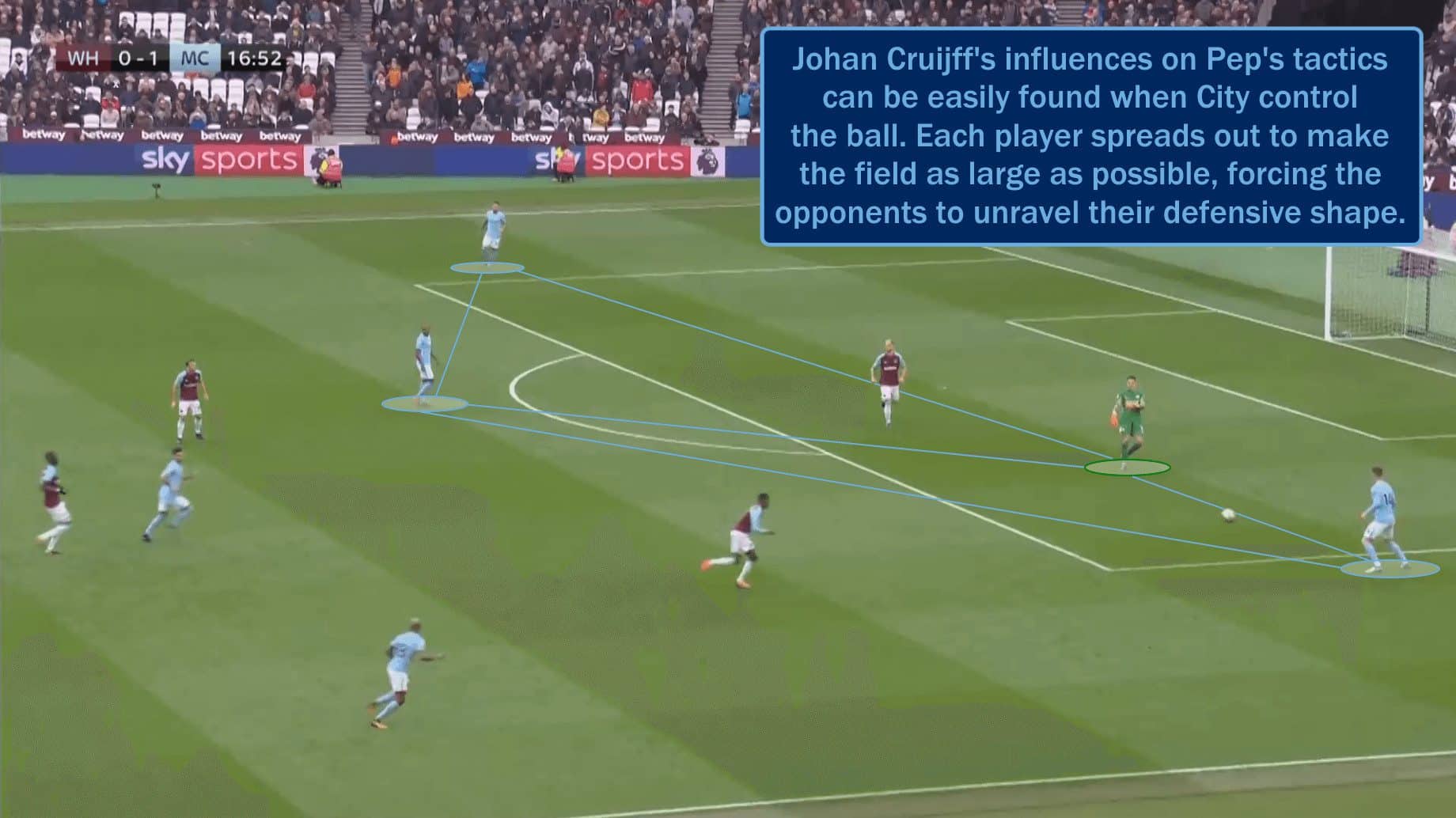
Despite being known as one of the Premier League and Europe’s best attacking outfits, City were able to maintain a very good defensive record. By virtue of creating overloads and advantages when going forward, the Sky Blues were very well-positioned to counter-press the opposition once losing the ball. This is quite a similar outcome seen with Maurizio Sarri’s Napoli side last season, which was statistically one of the best defensive sides on the continent despite playing beautiful, free-flowing attacking football.
Squad Evolution
To understand just how Pep Guardiola is going to transform this high-pressing, high ball-retention style for next season, we need to look at the personnel on the pitch. After all, tactics are no good if the players available are not able to fulfil the required duties (ala Manchester City’s full-backs in Pep’s inaugural season).
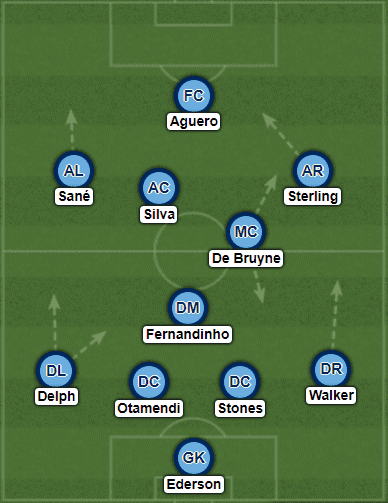
Defence
For a majority of last season’s Premier League, Manchester City played in a fluid 4-3-3. Ederson was a revelation in goal after signing from Benfica as his long passing ability and accuracy were crucial in building from the back or relieving pressure successfully. Kyle Walker’s pace and dribbling down the right flank make him a sure-fire starter this season, while Danilo will surely fall into a rotational role again.
On the left, Benjamin Mendy will take over for makeshift full-back Fabian Delph and will act in a more aggressive role than Walker, overlapping the forward line to send in crosses. Mendy’s attacking spirit is what originally persuaded Guardiola to play with wing-backs, but a long injury saw City settle into the dominant four at the back instead of five.
The first real sign of trouble — if you could call it that — is the central defence area. Manchester City possess four quality center-backs including former record signing Aymeric Laporte. The left-footed Frenchman is likely to gain a place in the lineup considering his great passing ability, but competition is fierce. Both John Stones and (especially) Nicolas Otamendi have proven to Guardiola that they have the knowledge and technique to start an attack with short or long passes. Even captain Vincent Kompany has revitalised himself after years of injury problems.
Midfield
Brazilian midfielder Fernandinho was a crucial piece in City’s Premier League title campaign. His defensive recovery, as well as his smart passing under pressure, alleviated a lot of the difficulties that plagued City’s defence in years prior. Unless the club finds a backup, Fernandinho will be the only completely reliable defensive midfielder in the squad next season. Both Delph and Ilkay Gundogan have certain traits allowing them to perform the role, but I wouldn’t be surprised if Oleksander Zinchenko steps in as a backup. The attacking midfielder turned left-back played in the 6 role as City took on Liverpool during the pre-season and was the most impressive player on the pitch.
Kevin de Bruyne’s free 8 role let him drop deep to start ball progression and influence play in the final third. He was City’s most important player last season and certainly their best performer. Combining with David Silva further up the field, the two were a formidable unit in keeping the ball and creating countless chances. With Bernardo Silva and potentially Riyad Mahrez able to slot into Silva’s advanced position, Guardiola should be able to play with a variety of midfield setups. Did I hear someone say ‘diamond midfield’?
Attack
The aforementioned Bernardo and Mahrez shall provide stern competition for Raheem Sterling, whose movement on the right flank was a revelation last season. Leroy Sané, the more traditional of the two wingers, helped to spread the pitch by pulling defenders wide to the touchline. The German has no true backup, save for a change of formation, and I have been adamant that City should continue to search for left-wing cover. Jack Harrison’s performances in the U.S. have been valiant, but the young Englishman doesn’t have that ‘X’ factor like a Mahrez or Gundogan does off the bench.
Finally, up top, Manchester City possess two top forwards in Sergio Aguero and Gabriel Jesus. The veteran Aguero is the more likely to start, but Pep Guardiola has made it no secret that the Brazilian can usurp the Argentine’s place at any moment. However, if Pep happens to experiment with a 5-3-2 variation like he did early last season, we could be seeing both players side-by-side.

Constant Tactical Evolution
The best way to learn something is to teach it. This phrase applies to most walks of life, especially the skills and tactical nuances of the beautiful game. Pep Guardiola is constantly teaching his players new directions, new cheat codes to create space and unlock defenses. In doing so, Guardiola learns something himself. Whether it’s following Raheem Sterling around on the training field, explaining to him when and why he must turn his body, or on the sideline of a Premier League match screaming at his team, Pep is both giving and receiving.
“[Pep’s] creative process is straightforward. He has a job to do, a game to win and needs to identify all potential threats and barriers. He must analyse his opponent and then devise new and better ways of using his resources (players, positions and roles) to achieve optimum results. At the end of this process he is left with the final ‘product’ which often, though not always, might be described as innovative.”
— Martí Perarnau
Knowing what we know about the Catalonian, then, we know that attempting to portray a blueprint for City’s entire 2018/19 campaign is downright impossible. Absolutely futile. He will study his own team and the opponent before making adjustments that he feels will win them the match. One may argue that his way of thinking just so happens to produce what we like to call “beautiful football” because it is rational, not because it’s an end goal.
Post-Modern Tactics
Just as Guardiola invents new ways to play football when confronted with affronts to his current style, the Spaniard may also do this when presented with gifts. More specifically, Manchester City’s manager has been presented with the gift of squad depth in key areas. Besides the previously discussed 6 role and left-wing, each position has at least two players who could competently fulfil them. With attacking midfield positions especially showered with talent, we could see Pep evolve his 4-3-3 into something yet discovered.
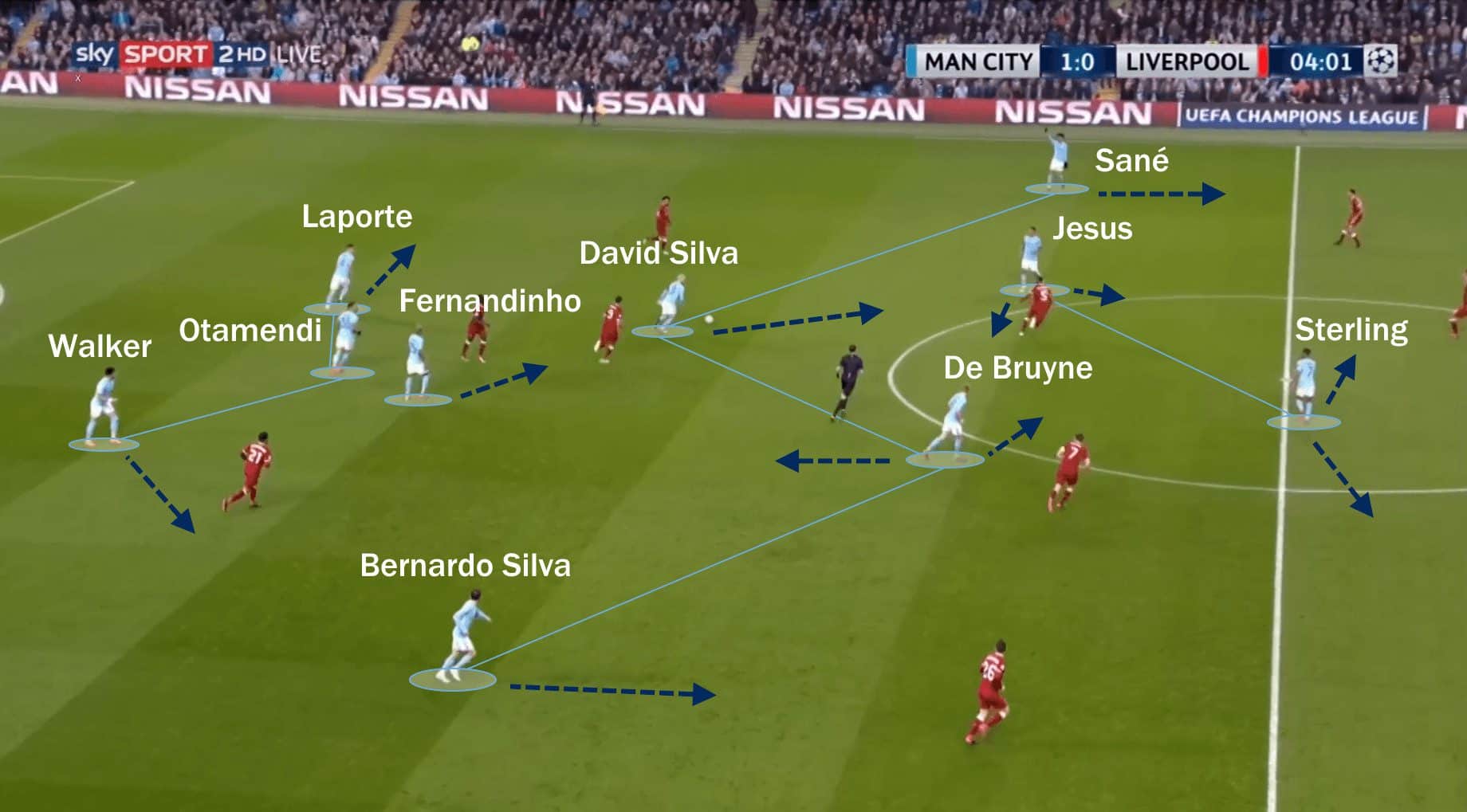
On April 10, 2018, Liverpool visited the Etihad Arena to finish off Manchester City. They’d won 3-0 at home in the first leg of the Champions League Quarter-Finals against the to-be English champions. Jürgen Klopp presented his usual mesmeric yet sturdy 4-3-3, but Pep Guardiola did not. His team needed a miraculous, epic victory. So he mixed it up and went for it. Six attacking players: three creative midfielders, a winger, and two strikers. In many ways, it was a 3-1-4-2.
The nearly suicidal formation had one purpose: to control the ball in Liverpool’s final third. And for the first 45 minutes, it worked wonders. Gabriel Jesus scored an early goal to pull one back and City kept at it. Whenever City went forward, they moved as one attacking unit. Numerical superiority was created all over the pitch, and when the ball was lost there was nowhere for Liverpool to dribble.
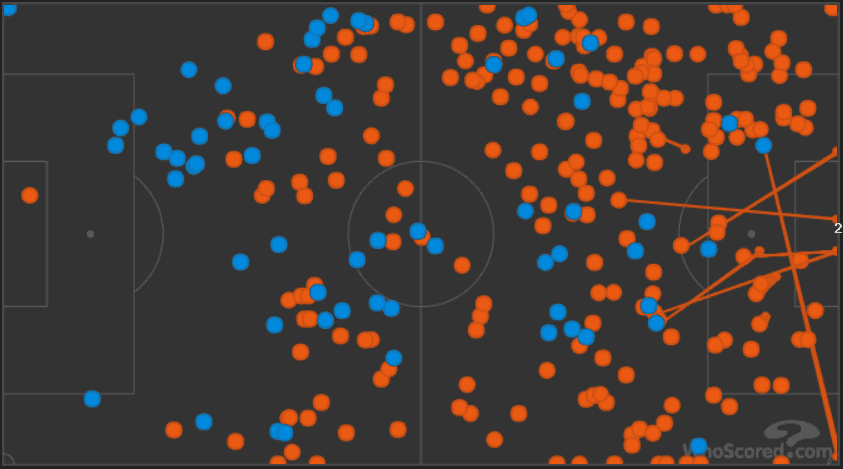
Manchester City didn’t completely control the first half, at least not by their standards, despite having over 70% of the ball. Liverpool were often able to counter-attack and fashioned a chance or two. Yet it was the moments when the blue shirts drove forward that City had their opponents trembling.
There is no doubt that Pep Guardiola had practiced this formation with the team in one way or another. He meticulously prepares every tiny detail, every possibility. If he likes what he saw and believes the extreme numerical superiority in the final third to be advantageous in a regular match, you won’t hear any surprising gasps from my end. The addition of Mahrez means yet another attacking presence vying for match time and another option to experiment with a revolutionary setup.
In their pre-season match against Liverpool, Guardiola set City up with three/five defenders. Perhaps he’s already preparing to evolve the 4-3-3 into something different for this season’s Premier League.
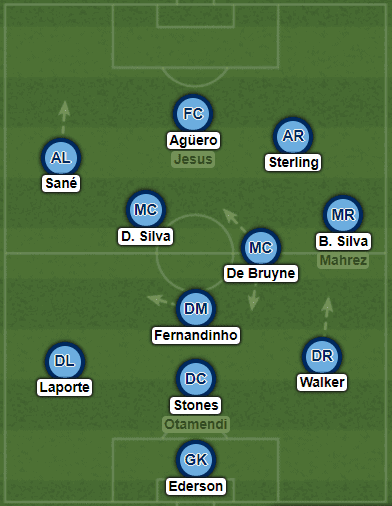
Conclusion
Manchester City are prepared to take on Europe’s best for the next half-decade, even if and when Pep Guardiola does depart. Ederson, Laporte, Stones, De Bruyne, Bernardo Silva, Sterling, Sané, and Jesus all have years of prime footballing ahead of them, while City’s massive budget will surely see a fair few supplementary additions in the near future. In 2017/18, Guardiola showed England that he could succeed in the Premier League, busting a stupid and drawn-out myth that the Spaniard was somehow a fraud. The upcoming season will not make or break either his or the club’s reputation, but the opportunity to build upon domestic success with a Champions League trophy is undeniably weighing on everyone’s mind.
The allure of a well-oiled Guardiola team is obvious. And with City finally clicking on high gear, everyone’s eyes will be on the English champions come two weeks time. The Citizens have managed to add onto an already brilliant squad, meaning the core concepts of possession and compression in the opponent’s final third will remain. Yet, there still seems to be another level Manchester City can take it to. Will Pep’s City remain in high gear, or will they turn on the turbo and blow *everyone* out of the water?





Comments